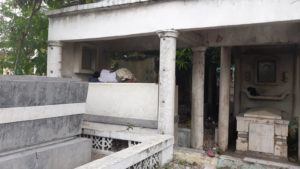
Shanties built out of the remains of old and abandoned mausoleums in the Cebu Chinese Cemetery line up the road looking like eyesores to passersby. | Photo by Morexette Erram
CEBU CHINESE CEMETERY
Never in her life did Janeth Hermogino expect to live among the dead. But the mother of five children, who earns a living doing laundry, now finds herself sleeping inside what used to be a mausoleum in one of Cebu’s oldest cemeteries.
Janeth and her husband had built a two-storey shanty inside the Cebu Chinese Cemetery.
Inside their dimly-lit home, the only remnants of the mausoleum that once stood there are two concrete pillars being used to support the second floor.
“Wa na mi kabalo kinsay pamilya nanagiya dinhi sa una kay pagabot namo dinhi, wala nay sulod ang nitso (We don’t know who owned this before because when we got here the tomb was empty),” said Janeth.
The Hermoginos have been living inside the cemetery for more than a year, when a family conflict forced them to flee their grandparents’ house in Barangay Luz.
“Naa mi dinhi kay wa man mi lain padulngan. Unya naanad na mi (We are here because we don’t have anywhere else to go. We’re now used to it),” said Janeth whose family was among a recent group of informal settlers who found shelter in the rundown mausoleum.
The 4.4-hectare compound in Barangay Carreta was once a sight to behold, with towering replicas of pagodas and unique Chinese architectural designs, inspired by feng shui principles, that marked the final resting place of some of Cebu’s prominent members of the Chinese community.
Among those buried inside the Cebu Chinese Cemetery are Manuel Gotianuy, the father of lawyer Augusto Go who owns University of Cebu, the Unchuans, Doña Modesta Gaisano and some of her deceased children. Historians said that its arch along M.J. Cuenco Avenue has also withstood World War II.
Now, the graveyard, which will celebrate its 110th founding anniversary in 2019, appears to have become a last resort for families who could not afford to live anywhere else in the city.

Indigent settlers sleep on niches inside a mausoleum in the Cebu Chinese Cemetery. | Photo by Morexette Erram
Aside from shanties, other traces of human occupation such as makeshift hammocks and benches, pens for ducks and chickens, clothesline attached from one mausoleum to another, drums of stored water, and uncollected garbage are found inside the historic graveyard.
According to a regular caretaker of one of the remaining mausoleum’s inside, the number of informal settlers living in the cemetery has recently grown.
The caretaker, who refused to be named, said most of the settlers take advantage of the house-like structures of abandoned mausoleums.
“Hilom sad dinhi unya naay guard sa Ludo magsuroy-suroy panalagsa. Basin mao sad na ganahan sila dinhi mamuyo (It’s peaceful here and there are guards from the nearby Ludo Cemetery going on patrol sometimes. Maybe that’s why they prefer living here),” he said.
The caretaker also noted that the cemetery itself has a sub-urban feel with several shanties built near tombs and mausoleums lining up the cemetery’s roads.
Looking like small houses in a low cost subdivision, he said the only thing lacking for the settlers were proper plumbing and electricity.
But even so, some residents have managed to install television, while others opened up a sari-sari store or sell snacks like banana cue to people in the neighborhood.
“Naa gani dinhi sa gabii mag karaoke. Mura lagi ka ug nipuyo og subdivision (There are even people here who do karaoke at night. It’s like living in a subdivision),” he said.
For Jocelyn Tampus, another dweller, the cemetery’s urban feel was among her reasons for staying there since 2013 when her house near the cemetery was demolished.
“Hangin sad dinhi. Dili samok. Wala man say kawat. Naa man tingali pero kanang manglungkab ug nitso para manguha ug alahas sa mga patay pero gabaan man gyud sila ana (It’s also windy here and peaceful. There are no robberies except perhaps when thieves force open the tombs to steal jewelry worn by the dead. But they will suffer karma for it),” Jocelyn said.
Like Janeth, the house where Jocelyn and her two children live stands on top of an abandoned mausoleum.
She, too, does not know who were buried there before.
Jocelyn hopes to find a better place to live in someday — a wish shared by Janeth.
“Basta makakita lang mi ug trabaho nga makaya ug abang nga sakto nga balay (If we could only find a job that would allow us to rent a decent house),” said Janeth.
Disclaimer: The comments uploaded on this site do not necessarily represent or reflect the views of management and owner of Cebudailynews. We reserve the right to exclude comments that we deem to be inconsistent with our editorial standards.
